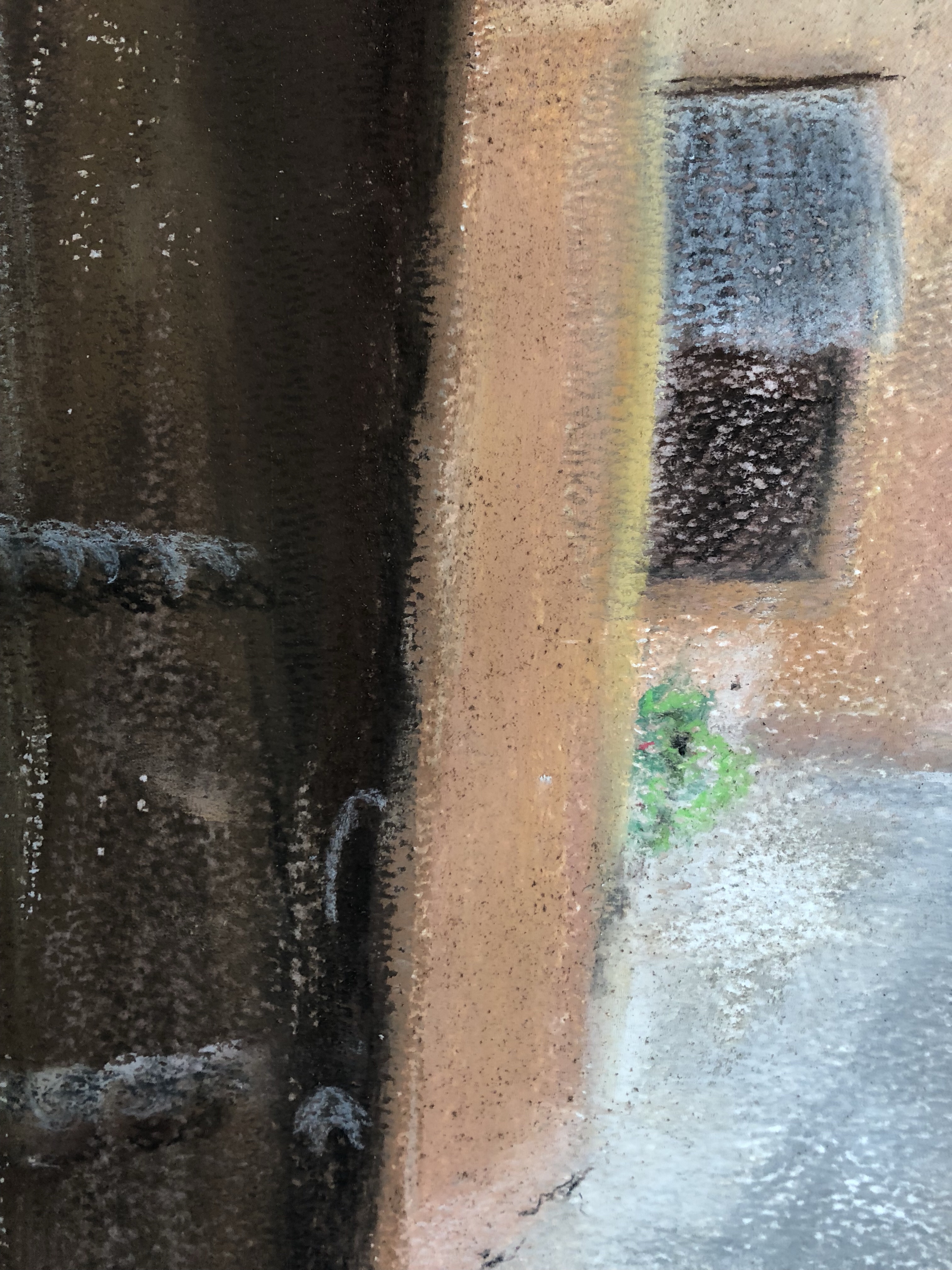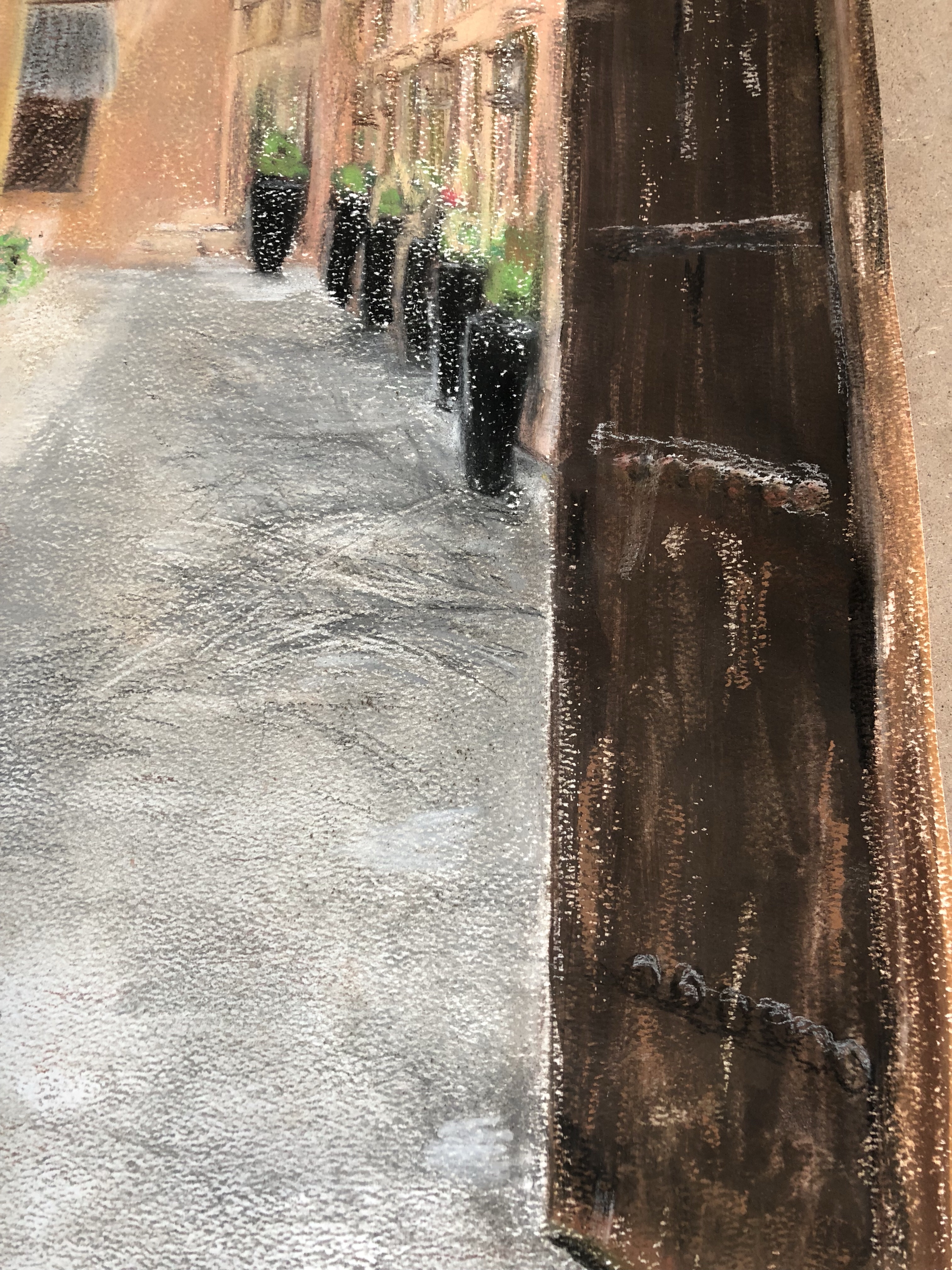The assignment asks of me to draw an outdoor scene of my choice – the view should also allow you to demonstrate your understanding of aerial or linear perspective.
My reference to the handbag looking like a window in a previous post on perspective is a thought I would like to continue for this assignment – I am influenced by seeing and interpreting this with lines – a window has the abilities to show what is in front of it, and reflect images and moments. I read the following on the meaning of the word WINDOW: c. 1200, literally “wind eye,” from Old Norse vindauga, from vindr “wind” (see wind (n.1)) + auga “eye”. Replaced Old English eagþyrl, literally “eye-hole,” and eagduru, literally “eye-door.” The English word for “door” comes from the Old English duru or dor.
Above Palm tree is in our garden and I can view this tree from our bedroom. I learnt that the dates have been harvested a few weeks ago. I look forward to living here and getting to understand the value of the date trees is this culture.

DEIRA and the LOUVRE, ABU DHABI
During beginning August 2018, we relocated to Dubai and I am still overwhelmed by the skyscrapers and impressive city- a dessert tamed by man’s imagination and determination. Outside in the garden, a huge palm tree – greyish and swirling in the winds reminded me of a changing landscape of desert and sand dust. We made plans to visit the Louvre in AbuDhabi, and I had time to read as much as I can about the design of the Louvre.
In his spectacular design for the Louvre, the French appointed architect, Jean Nouvel, took the hard shadows of palm fronds in an oasis as inspiration. Like a traditional Arab village, the entire museum consists of 55 white cubic houses roofed by the large, shade-giving dome. He wanted to create a “Rain of Light”: sharp bundles of light that would transform the walls and squares into a speckled, surreal world as opposed to the balanced light relationships found in the exhibition spaces, such as direct lighting from spotlights. I started looking at the negative shapes between the huge palm leaves, with new eyes, we have driven out to the dessert and experienced the heat and the need for humans and animals to take shelter under a tree.
Before our move to Dubai I read about a South African fabric designer who makes Botanical Blueprint and Silverprint Silhouette hand printed textiles. I was intrigued by the process of printing she uses – as the sun does the printing. The method is called Cyanotype process and was discovered in 1842 by Sir John Herschel (1792 – 1871). This process was preceded by the Daguerreotype and silver photographic process, and the prints are blue. I did a bit of research and found a local supplier, but could only get the product shortly before we left, I opted to have it packed in our container, much to my later frustration! ( the kit contains 10 grams of Potassium ferricyanide and 25 grams of Ferric ammonium citrate) I realise this is a drawing course, but the idea of using light to create lines, intrigued me to push the option during the preliminary studies.

a Short video capturing the movement of the palm leaves in the wind. I hope to capture the light playing in the shadows.
[wpvideo 4O7zmSmD ]
Staying with the Rain of Light, I used a photo my husband took of me under this amazing roof of the Louvre, AbuDhabi. The finished drawing reminds me of the drawing of my cousin at Circa in an earlier post. I read the following and feel it needs to be noted here: ‘Nature is not only all that is visible to the eye, it also includes the inner pictures of the soul” Evard Munch. I do believe this is what landscape art should bring to the viewer.

my assignment choice: Looking at previous sketches I used a photo of a view through a door in the Deira area. This view allows me to demonstrate my understanding of linear perspective, and I need to bring in an atmosphere of an old city and creating an illusion of depth. I used pastels and charcoal. Through the open door I attempted to lead the viewer’s eye deep into the scene giving the illusion of reality – a street where people go about their daily life, and also see the angles along the road towards the horizon line. As I worked longer on the drawing, I started to notice more subtleties, and by coming back to the drawing, my eyes noticed other areas that need changing. I did not finish the drawing in one sitting of 2 hours, but spent a few days, of coming back, looking more at the scene and trying to create atmosphere.




a view into a compound where people are living. I hope to share a bit of mystery and melancholy in this drawing, as it is of a culture I know very little and presumably will stay a mystery. During this time I started watching a documentary series, called, Wild Arabia, and ‘stole’ a shot from the video – as this view just captured me.

I did a quick charcoal and conte pencil drawing – then painted with my paintbrush dipped in the dry hibiscus watery mix. I used a paper I prepared with rough marble dust mixed with acrylic paint.
I tried to focus on shadows on the buildings and suggest a palm tree overhanging the door, with shadows and light playing on the street next to the buildings. I found dried hibiscus flowers at the Souk and decided to wet it and use it as a paint over the doors of the entrance into this scene. This wetting of the paper, caused the surface to curl on the sides. I removed the masking tape too soon, while paper was wet. I had to use a ruler for the lines of the buildings and the door frame, but attempted, with the pastels, so soften these lines and create more atmosphere with the use of colour and blurring.
Assignment Piece for Part three

Reflecting on work done in this part of the studies
Reflecting on Part Three was difficult, mainly for the reason of our re location – it felt as if I lost a bit of traction and had to familiarise myself with the new surroundings, and looking back at work I started on a while ago. I found the research material very stimulating and it is as if landscape became more than just the beauty of the world around me – I feel I started to look more and find nuances in light and space around me. I feel strong about spending time outside and getting to know the landscape around me, in order to draw it. I had constraints when we moved here – our container with our belongings only arrived by end of August. I had one sketch/note book with me and a few pastels, charcoals and pencils. I did a lot of city scapes, using photo’s I took as we were driving around the city. I found a roll of paper ( the owner must have left it after their house was packed) and sat flat on the floor of the living room doing drawings. My WordPress blog was also giving me issues – I bought a new computer early September as I realised my old laptop was not very compatible with uploading images.
I experimented with a few drawing mediums which I have never used before:
- dried hibiscus flowers diluted and painted drawing
- black paper and white chalk
- aloe vera gel diluted with water on coloured pencils
- creta blocks diluted with water
- ink
- watercolours
I did not achieve in my effort to incorporate the moving shadows of the palm trees – should I have put more thought and time into this effort? I think so. I appreciated the note about Part Four, and spend some time on this before we left South Africa, which, I am now grateful for, as using and finding a model can pose a problem where I currently live.
TUTOR feedback on Part 3
10 October 2018
Overall comments from my tutor
My tutor is satisfied with my work and this is a great motivator for me! He sees growth in my visual language and a fresh and fluid approach to drawing, as well as good reflections in my blog about my learning and trying to bring this to my own artistic growth.
My tutor challenged me to push further and explore and experiment with drawing media. I mainly draw with charcoal, B3 -8 pencils and pastels – I question my own understanding of drawing during this idea developing process. I hang onto ” all that drawing requires is imagination, creativity, and skill” – (Vitamin D) I would like to explore more with acrylic, ink, prints and ink, watercolour on paper, found organic materials (natural grasses/leaves/stones/sand/dust – shadows and movement in video and photos. I am inspired by the artist, Maggi Hambling talking about ongoing experiments” in your work practice, “otherwise the work is dead”! Drawing is still her daily routine as a portrait painter. Other thoughts on this: painters such as Van Gogh said “don’t paint what you see but what you feel.” The difficult part is to truthfully find your own way, by trial and error, your own personality, your own way to express things, and to arrive at a place where you can recognise yourself. You reach that place only by being yourself. This process takes time, needs practice and effort.
I am now nearing the end of the Drawing 1 course and my thoughts are how my own creative skills and confidence grew during the process. I need to reflect on my own visual language and how this is constantly developed during the learning process. I was encouraged by my tutor, with regards to experimentation and exploration. I am encouraged by the feedback and need to use these suggestions in by working process. My tutor commend my use of video and photo material into my drawing process. I would like to explore this more.